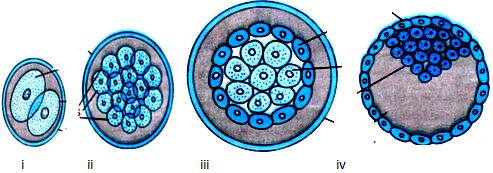Question
Match the figures with the respective descriptions.


- Daughter cells that are formed are known as blastomeres.
- There is no growth phase between divisions during cleavage.
- Mammalian blastula that contains two distinct cell lineages.
- Inner cell mass becomes the embryo itself and trophoblast cells help implantation in the uterine wall.
Answer: Option C
:
C
The single-celled zygote undergoes cleavage to form 2 cells. Its called cleavage becauseunlike normal mitosis, there is no growth phase between divisions. The embryo further divides to form 4 cells, which divide to form 8 and then 16 cells, and so on. These daughter cells that are formed are known as blastomeres. Once the embryo has reached 8 to 16 blastomeres, it is known as a morula. The morula is the first embryonic stage where mammalian cells can be categorized into internal or external. The internal cells called the inner cell mass or ICM will eventually become the embryo itself and its surrounding membranes, whereas the external cells, called trophoblast cells play a key role in the process of implantation in the uterine wall. A blastocyst is a mammalian blastula that contains two distinct cell lineages. In the blastocyst, the trophoblast cells remain in a single outer layer surrounding the blastocoel, and the cells of the ICM form a mass of cells on the inner surface on one side of the blastocyst.
Was this answer helpful ?
:
C
The single-celled zygote undergoes cleavage to form 2 cells. Its called cleavage becauseunlike normal mitosis, there is no growth phase between divisions. The embryo further divides to form 4 cells, which divide to form 8 and then 16 cells, and so on. These daughter cells that are formed are known as blastomeres. Once the embryo has reached 8 to 16 blastomeres, it is known as a morula. The morula is the first embryonic stage where mammalian cells can be categorized into internal or external. The internal cells called the inner cell mass or ICM will eventually become the embryo itself and its surrounding membranes, whereas the external cells, called trophoblast cells play a key role in the process of implantation in the uterine wall. A blastocyst is a mammalian blastula that contains two distinct cell lineages. In the blastocyst, the trophoblast cells remain in a single outer layer surrounding the blastocoel, and the cells of the ICM form a mass of cells on the inner surface on one side of the blastocyst.
Was this answer helpful ?
More Questions on This Topic :
Question 3. How is breast cancer detected?....
Question 5. Hernioplasty is the procedure to cure....


















Submit Solution